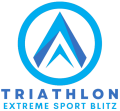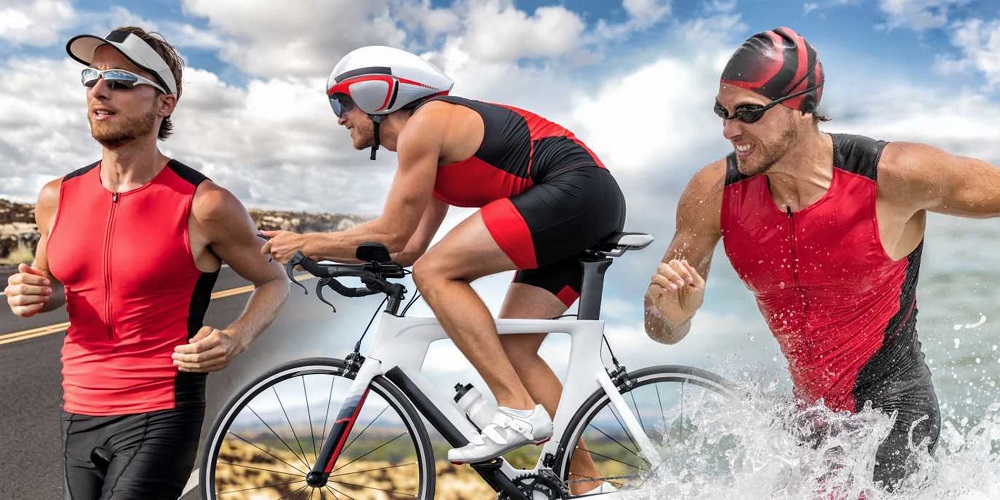Are you ready to push your physical and mental limits? The world of triathlons combine swimming, biking, and running into one grueling race that tests the endurance and athleticism of its participants.
But within the realm of triathlons, there is one event that stands above the rest: Ironman. This iconic race has captured the hearts and minds of athletes around the globe, becoming a symbol of determination and strength. But how does Ironman compare to a traditional triathlon? Let’s dive in and explore this competition between two titans of endurance sports.
- Ironman – the granddaddy of all triathlons. A 2.4-mile swim, 112-mile bike ride, and 26.2-mile run make up this ultimate test of endurance. On the other hand, a typical triathlon features shorter distances – a 0.93-mile swim, 24.8-mile bike ride, and 6.2-mile run – making it a slightly less daunting feat for athletes.
- But make no mistake – both Ironman and triathlon require months of intense training to build endurance and strength in all three disciplines. Mental toughness is also put to the test in both events, but Ironman takes it to another level with its longer distances and extreme conditions.
On race day, you can expect a more laid-back vibe at a traditional triathlon with smaller crowds compared to the high-energy atmosphere at an Ironman event. Both offer unique experiences for athletes brave enough to take on the challenge.
So which one will you choose? The ultimate challenge or a slightly less daunting feat? Whichever you decide on, one thing is for sure – both Ironman and triathlon will leave you with unforgettable memories and a sense of accomplishment that few other races can match.
Table of Contents
Understanding Triathlon
The differences between an Ironman and a regular triathlon are quite significant, encompassing distance, time, training, and race experience. Ironman is a grueling endurance race that pushes athletes to their physical limits, involving a 2.4-mile swim, 112-mile bike ride, and a full marathon run.
In comparison, a regular triathlon can have varying distances for each leg, ranging from the shortest sprint triathlon (750-meter swim, 20-kilometer bike ride, and 5-kilometer run) to longer courses.
But make no mistake, regardless of distance, a triathlon is a challenging multi-sport event that demands incredible physical and mental strength.
Moreover, Ironman races are notorious for their challenging courses and extreme conditions. From strong currents in the swim to steep climbs on the bike and grueling heat during the run, these races demand peak performance from athletes. It takes not only physical strength but also mental fortitude to push through the toughest moments of an ironman.
Getting to Know Ironman
The key distinction between an Ironman race and a regular triathlon lies in the level of difficulty and distance of the event. While a regular triathlon may vary in distance and complexity, the Ironman race, trademarked by the World Triathlon Corporation (WTC), has a set distance of 2.4 miles for swimming, 112 miles for cycling, and 26.2 miles for running, all completed consecutively without breaks.
On the other hand, regular triathlons can be shorter in distance and can typically be completed in a few hours. The distance may range from a sprint distance (around 750 meters swim, 20 kilometers bike, and 5 kilometers run) to an Olympic distance (1.5 kilometers swim, 40 kilometers bike, and 10 kilometers run). There are also longer distances such as the half Ironman or middle-distance triathlons (1.9 kilometers swim, 90 kilometers bike, and 21.1 kilometers run).
Aside from the difference in distance, there are also variations in course terrain and conditions between an Ironman race and regular triathlons. Ironman races are renowned for their challenging courses, with steep hills and rough terrain for both cycling and running portions. In contrast, regular triathlons may have flatter and more manageable courses.
Moreover, the preparation and training required for an Ironman race is much more demanding than that of regular triathlons. Due to its extreme distances and conditions, training for an Ironman race can take up to six months or even longer. Athletes must focus on building up their endurance, strength, and mental toughness to successfully complete an Ironman event.
Ironman vs Triathlon: A Comparison
When comparing an Ironman race to a traditional triathlon, there are notable differences in distance, training, equipment, community, recovery time, and entry fees.
| Ironman | Traditional Triathlon | Difference |
| A distance of 2.4 miles for swimming, 112 miles for biking, and 26.2 miles for running | Variable distances for each discipline | Significant difference in overall distance |
| Requires 12-30 hours of training per week | 5-12 hours of training per week | More intense training required for Ironman events |
| Necessitates top-tier equipment | Allows for more flexibility in gear choices | Difference in equipment requirements |
| Typically takes 12-14 hours to complete the race | Average finishing time of 3 hours for Olympic distance events | Significant difference in race duration |
| Fosters a strong sense of community among participants | No distinct community aspect | Difference in community atmosphere |
| Requires 2-4 weeks of recovery time after the race | Varies from person to person | Difference in recovery time needed after the event |
| Entry fees tend to be higher for Ironman races | Lower entry fees for local triathlon events | Difference in cost of participation |
| The term “Ironman” is trademarked and can only be used by WTC events | Can be used by any triathlon event organizer | Difference in trademark and exclusivity |
Training for Ironman and Triathlon
When it comes to preparing for an Ironman race and a standard triathlon, many may assume that they are similar in approach and preparation. However, upon closer inspection, there are significant differences between the two events.
Here, we will explore the key ways in which training for an Ironman diverges from training for a standard triathlon.
Distance:
The most prominent contrast between the two events is the distance. An Ironman race consists of a grueling 2.4-mile swim, followed by a 112-mile bike ride, and culminating with a full marathon of 26.2 miles.
On the other hand, triathlons have varying distances, with the most common being a 0.93-mile swim, followed by a 24.8-mile bike ride and a 6.2-mile run. This means that training for an Ironman requires a higher level of endurance and physical preparation.
Intensity:
Due to the longer distances involved in an Ironman race, the training intensity is also higher compared to a standard triathlon.
Ironman athletes must focus on building endurance through long-distance training sessions and incorporating high-intensity interval training to improve speed and stamina.
Equipment:
Another notable difference between the two events is the equipment required. Ironman races demand top-of-the-line gear for reliability during the extreme race conditions, including a high-quality bike, wetsuit, and running shoes.
On the other hand, triathlons allow for more affordable gear options, making it more accessible for beginners or those on a budget.
Community Support:
The Ironman community is renowned for its strong bond among participants due to the shared experience of completing such a challenging event.
Training for an Ironman often involves joining local groups or online communities for support and motivation.
In contrast, standard triathlons may not have as strong of a community aspect.
Recovery Time:
Due to the longer distances and higher intensity of an Ironman race, recovery time after the event can take up to four weeks.
In comparison, recovery from a standard triathlon varies depending on individual factors such as fitness level and race intensity.
Expenses:
Participating in both Ironman and triathlon events involves various expenses, including entry fees and pre-event costs like gear investment.
However, Ironman races tend to be more expensive due to the longer distances and higher equipment requirements.
Physical and Mental Endurance
Physical and mental endurance are key components of both Ironman and triathlon races. However, there are notable differences between these two challenging events.
Let’s take a closer look at how these races differ in terms of physical and mental endurance.
| Physical Endurance | Ironman | Triathlon |
| Distance | An Ironman race involves a grueling 2.4-mile swim, followed by a 112-mile bike ride, and capped off with a full marathon run of 26.2 miles. | In contrast, triathlons come in varying distances, such as the popular Olympic distance which consists of a 0.93-mile swim, 24.8-mile bike ride, and a 6.2-mile run. |
| Training intensity | Training for an Ironman requires intense preparation, often involving up to 30 hours per week. | On the other hand, triathlon training can be less daunting with shorter distances and offers a better balance between training and personal life. |
| Pacing strategy | A careful energy management strategy is crucial in an Ironman due to its longer duration (up to 17 hours). | In comparison, triathlons tend to have a more aggressive pace due to their shorter distances. |
| Equipment | Top-tier equipment is necessary for the extreme nature of an Ironman race. | In contrast, there is more flexibility in choosing equipment for triathlons. |
| Mental Endurance | Ironman | Triathlon |
| Nutrition and mental resilience | An Ironman race requires a combination of proper nutrition and mental resilience due to its longer duration (up to 17 hours). | While still important, triathlons may be less daunting in terms of nutrition and mental resilience due to their shorter distances. |
| Community support | Ironman races often foster a strong bond among participants due to the shared experience of completing such a challenging event. | In contrast, the triathlon community is more diverse, with varying race distances and a focus on inclusivity and personal growth. |
Transition and Strategy
Transition is a critical element in Ironman and triathlon competitions, as it involves changing gear and equipment between each section. However, there are notable distinctions in transition and strategy between these two types of races.
To begin with, Ironman races cover a 2.4-mile swim, 112-mile bike, and 26.2-mile run, whereas triathlons can vary in distance depending on the specific event. This means that transitions in Ironman races are usually longer due to the greater distance covered in each segment.
Furthermore, Ironman races have strict cutoff times for each section as well as the entire race. This implies that athletes must have a well-thought-out plan to ensure they finish within the designated time or risk being asked to leave the course. On the other hand, triathlon races may have varying cutoff times, but they are typically more flexible compared to Ironman races.
Training for an Ironman is also significantly more time and energy-intensive than training for shorter triathlons. Completing an Ironman is often a long-term goal for many triathletes, requiring months of dedicated training to build endurance.
While both race types involve swimming, cycling, and running, Ironman training focuses on building endurance while training for shorter distances emphasizes speed. This also impacts transition strategies, as Ironman transitions may involve more time-consuming tasks such as changing into fresh gear or refueling with nutrition.
Lastly, it is important to note that “Ironman” is a trademarked name and refers specifically to events organized by the company Ironman. Other races covering the same distance are referred to as “Iron-distance” races when organized by other companies. This branding also plays a role in the transition and strategy aspect of these races, as athletes may need to adjust their plans based on race-specific rules or regulations.
The Gear
In order to succeed and endure through the challenging events of Ironman and triathlon races, having the right gear is crucial. From the first swim leg to the final run leg, each piece of gear plays a significant role in helping athletes achieve their goals.
Here, we will explore the must-have gear items for these races and provide insights into how they can enhance performance.
Gear for the Swim Leg:
The swim leg may be the shortest segment of an Ironman or triathlon race, but it sets the tone for the rest of the event. Therefore, having the right gear is essential. A well-fitted wetsuit is crucial as it provides insulation, buoyancy, and reduces drag in open water.
Additionally, goggles with anti-fog properties are necessary for clear vision throughout the swim. A swim cap can also be beneficial as it not only keeps hair out of the face but also provides insulation and reduces drag.
Gear for the Bike Leg:
The bike leg is where most of the action happens in an Ironman or triathlon race, covering long distances and requiring significant physical effort. As such, investing in a triathlon-specific bike with aerodynamic features can greatly improve performance.
It’s also important to have a comfortable and well-fitted helmet that meets safety standards. Cycling shoes are another vital gear item as they provide a secure fit and efficient energy transfer from legs to pedals.
Gear for the Run Leg:
The final leg of an Ironman or triathlon race is the run leg, which can be demanding after already completing the swim and bike legs. Having high-quality running shoes with proper cushioning and support is crucial to avoid injury and maintain endurance.
Moisture-wicking apparel is also essential as it helps keep athletes cool and dry during this intense segment. Essential accessories like hydration packs or belts can also enhance performance by providing easy access to water or sports drinks.
Other Tips for Success:
While the gear mentioned above is essential, it’s also important to have a nutrition plan in place for the race. This includes having enough fuel and hydration to sustain energy levels throughout the event. Practicing transitions between legs can also save valuable time and improve overall performance. Additionally, developing mental strategies for endurance and overcoming challenges during the race can be just as crucial as having the right gear.
In conclusion, the gear needed for both Ironman and triathlon races plays a significant role in an athlete’s success. From specialized swimwear to top-of-the-line running shoes, each piece of gear serves a specific purpose and contributes to overall performance. By considering factors like fit, comfort, aerodynamics, and durability, athletes can ensure they have the best gear for their race.
History and Evolution
As Ironman and triathlon continue to evolve and attract a diverse range of participants, it’s essential to understand their history and evolution. The first recorded triathlon event took place in France in 1920, where participants completed a 3km run, 12km bike ride, and 3km cross-country run.
However, it wasn’t until the 1970s that the first Ironman event was held in Hawaii, consisting of a 2.4-mile swim, 112-mile bike ride, and a full marathon (26.2 miles) run. Today, both sports have expanded globally, with Ironman hosting over 170 events in various countries and triathlon being recognized as an Olympic sport since 2000.
The growth and popularity of these endurance sports can be attributed to their unique challenges and rewards. For many athletes, completing an Ironman or triathlon race is a personal accomplishment that requires months of dedicated training and discipline. It’s not just about physical abilities but also mental toughness and resilience. By pushing themselves to the limit, participants gain a sense of achievement and empowerment that carries over into other aspects of their lives.
Triathlon and Ironman Events Around the World
The world of triathlons and Ironman events has seen a significant surge in popularity in recent years, with athletes from all corners of the globe flocking to participate. Combining physical challenges with stunning scenery, these events are a must for any triathlete looking to push their limits.
Here are some of the top triathlon and Ironman events around the world, each with its own level of difficulty, location, and prestige.
Escape from Alcatraz Triathlon:
- Difficulty: High
- Location: San Francisco, USA
- Prestige: Legendary
Known as one of the most grueling races on the planet, the Escape from Alcatraz Triathlon kicks off with a daring jump off Alcatraz Island into the freezing waters of San Francisco Bay. The race continues with a swim across the bay, a hilly bike ride through sand dunes, and a final run along the iconic Golden Gate Bridge.
Norseman Xtreme Triathlon:
-
- Difficulty: Extreme
- Location: Norway
- Prestige: World’s Toughest
Considered one of the toughest triathlons in the world, the Norseman Xtreme Triathlon takes place in Norway and features a punishing ascent of 5,235m on foot and a swim in frigid waters. Only a select few athletes are deemed fit enough to participate in this prestigious event.
Ironman World Championship:
-
-
- Difficulty: High
- Location: Hawaii, USA
- Prestige: Iconic
-
The Ironman World Championship is the pinnacle of Ironman events, renowned for its prestige and worldwide recognition. Held in Hawaii, it allows athletes to experience the legendary course without having to meet strict qualifying standards. The race consists of a 2.4-mile swim, a 112-mile bike ride, and a 26.2-mile run.
Ironman European Championship:
-
-
- Difficulty: High
- Location: Frankfurt, Germany
- Prestige: Scenic
-
The Ironman European Championship takes place in the picturesque city of Frankfurt, Germany. The event boasts breathtaking scenery and a challenging bike course through historic sites, drawing athletes of all levels to compete.
Alaskaman Extreme Triathlon:
-
-
- Difficulty: Extreme
- Location: Alaska, USA
- Prestige: Adventurous
-
With its icy waters and rugged terrain, the Alaskaman Extreme Triathlon is not for the faint-hearted. Athletes are required to have their own support team to complete this demanding race, which includes a 2.6-mile swim, a 113-mile bike ride, and a 27-mile run.
IRONMAN Canada:
-
-
- Difficulty: High
- Location: Penticton, Canada
- Prestige: Challenging
-
IRONMAN Canada is renowned for its challenging and scenic course, offering stunning landscapes and a marathon through the city of Penticton.
Conclusion
In conclusion, the world of triathlons presents a multitude of challenges for athletes, but one event reigns supreme: Ironman.
This renowned race has captured the hearts and minds of athletes worldwide, embodying determination and fortitude.
While both Ironman and traditional triathlons encompass swimming, biking, and running, they diverge significantly in distance, training intensity, equipment requirements, community support, recovery time, and expenses.






